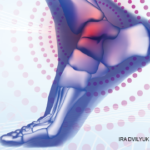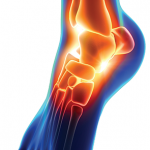A 60-year-old man returns for a follow-up related to his diagnoses of rheumatoid arthritis and chronic gout of his right ankle and foot, without tophi. He reports the gout flares have subsided in his ankle. He takes 450 mg of allopurinol daily. He has rheumatoid factor-positive rheumatoid arthritis, which previously affected multiple sites, without organ or systemic involvement. He says he has mild joint swelling and pain in his arms and legs upon getting up in the morning. His pain severity is at a 3 on a 10-point scale. He says the pain lasts for 15–20 minutes while he is getting dressed. He is currently on 10 mg of methotrexate weekly for his rheumatoid arthritis and feels he has improved since his last visit.
Past Family History: His father, who is no longer living, also suffered from gout.
Past Social History: The patient does not smoke or use any tobacco products. He does not drink alcohol.
Review of Systems
- Constitutional: Negative for chills, pallor, fatigue, fever, weight gain or loss;
- Neurologic: Negative for weakness or symptoms of neuropathy;
- Respiratory: Negative for cough, dyspnea, chest pain when breathing, wheezing;
- Gastrointestinal: Negative for anorexia, nausea, emesis, hematemesis, diarrhea, constipation, melena, abdominal pain, dysphagia, reflux, indigestion or heartburn;
- Skin: Negative for rashes or hair loss; and
- Musculoskeletal: Negative for back pain or muscle pain. Positive for symptoms noted above, including mild right ankle pain and swelling.
Physical Examination
General/Constitutional: The patient’s blood pressure is 122/80, weight is 216 lbs., temperature is 97.2° F, and he rates his pain at 3 on a 10-point scale. The patient is well nourished and well developed.
Musculoskeletal: The patient’s left ankle has slight swelling and slightly decreased range of motion (ROM). His left foot has mild swelling, no pain and mildly reduced joint ROM. He has no other joints with swelling or tenderness. The patient can bear his full weight without pain.
Cardiovascular: The patient’s heart has a regular rate and rhythm with no murmurs or friction rubs.
Respiratory: The chest sounds are symmetric, and the lungs are clear on auscultation.
Abdomen: The abdomen is soft with no masses or evidence of an enlarged liver or spleen.
Impression: The patient’s rheumatoid arthritis is well controlled, and his gout is improved, but with slight residual ankle swelling.
Radiologic Procedures: The left foot X-ray from the prior visit is reviewed and shows a heel spur and soft tissue swelling.
Laboratory Studies Reviewed: The test results from the previous visit, including a complete urinalysis, uric acid, C-reactive protein, ESR, CMP, CBC, differential and platelet count, are reviewed.
Assessment/Plan
The patient’s gouty arthropathy is improved. The patient’s present uric acid level is 4.0. The treatment is 450 mg of allopurinol daily and 0.6 mg of colchicine one or two times daily for acute flare. The rheumatologist emphasizes the importance of daily adequate hydration and maintaining a low purine diet. Different options for diet and an exercise plan are discussed. The rheumatologist orders new labs, uric acid and CBC and liver function tests to monitor methotrexate. The importance of calling for an appointment if he has an acute flare—so the fluid can be aspirated from the joint for crystal analysis—is stressed. The patient will continue taking 10 mg of methotrexate weekly for his rheumatoid arthritis.
Is this a level 99213 or 99214?
Editor’s note: Case vignettes presented in the Coding Corner are created to illustrate questions about coding. They are not intended to represent the full medical record of a case.

